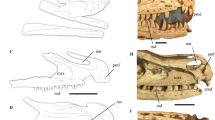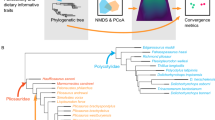Abstract
The Cretaceous–Paleogene mass extinction approximately 66 million years ago is conventionally thought to have been a turning point in mammalian evolution1,2. Prior to that event and for the first two-thirds of their evolutionary history, mammals were mostly confined to roles as generalized, small-bodied, nocturnal insectivores3, presumably under selection pressures from dinosaurs4. Release from these pressures, by extinction of non-avian dinosaurs at the Cretaceous–Paleogene boundary, triggered ecological diversification of mammals1,2. Although recent individual fossil discoveries have shown that some mammalian lineages diversified ecologically during the Mesozoic era5, comprehensive ecological analyses of mammalian groups crossing the Cretaceous–Paleogene boundary are lacking. Such analyses are needed because diversification analyses of living taxa6,7 allow only indirect inferences of past ecosystems. Here we show that in arguably the most evolutionarily successful clade of Mesozoic mammals, the Multituberculata, an adaptive radiation began at least 20 million years before the extinction of non-avian dinosaurs and continued across the Cretaceous–Paleogene boundary. Disparity in dental complexity, which relates to the range of diets, rose sharply in step with generic richness and disparity in body size. Moreover, maximum dental complexity and body size demonstrate an adaptive shift towards increased herbivory. This dietary expansion tracked the ecological rise of angiosperms8 and suggests that the resources that were available to multituberculates were relatively unaffected by the Cretaceous–Paleogene mass extinction. Taken together, our results indicate that mammals were able to take advantage of new ecological opportunities in the Mesozoic and that at least some of these opportunities persisted through the Cretaceous–Paleogene mass extinction. Similar broad-scale ecomorphological inventories of other radiations may help to constrain the possible causes of mass extinctions9,10.
This is a preview of subscription content, access via your institution
Access options
Subscribe to this journal
Receive 51 print issues and online access
$199.00 per year
only $3.90 per issue
Buy this article
- Purchase on Springer Link
- Instant access to full article PDF
Prices may be subject to local taxes which are calculated during checkout


Similar content being viewed by others
References
Alroy, J. The fossil record of North American mammals: evidence for a Paleocene evolutionary radiation. Syst. Biol. 48, 107–118 (1999)
Smith, F. A. et al. The evolution of maximum body size of terrestrial mammals. Science 330, 1216–1219 (2010)
Kielan-Jaworowska, Z., Cifelli, R. L. & Luo, Z.-X. Mammals from the Age of Dinosaurs: Origins, Evolution, and Structure (Columbia Univ. Press, 2004)
Van Valen, L. M. & Sloan, R. E. Ecology and the extinction of the dinosaurs. Evol. Theory 2, 37–64 (1977)
Luo, Z.-X. Transformation and diversification in early mammalian evolution. Nature 450, 1011–1019 (2007)
Bininda-Emonds, O. R. P. et al. The delayed rise of present-day mammals. Nature 446, 507–512 (2007)
Meredith, R. W. et al. Impacts of the Cretaceous terrestrial revolution and KPg extinction on mammal diversification. Science 334, 521–524 (2011)
Wing, S. L. & Boucher, L. D. Ecological aspects of the Cretaceous flowering plant radiation. Annu. Rev. Earth Planet. Sci. 26, 379–421 (1998)
Archibald, J. D. et al. Cretaceous extinctions: multiple causes. Science 328, 973 (2010)
Schulte, P. et al. The Chicxulub asteroid impact and mass extinction at the Cretaceous-Paleogene boundary. Science 327, 1214–1218 (2010)
Weil, A. & Krause, D. W. in Evolution of Tertiary Mammals of North America Vol. 2 (eds Janis, C. M., Gunnell, G.F. & Uhen, M. D. ) 19–38 (Cambridge Univ. Press, 2008)
Krause, D. W. in Vertebrates, Phylogeny, and Philosophy (eds Flanagan, K.M. & Lillegraven, J.A. ) 119–130 (Contributions to Geology, 1986)
Rich, T. H. et al. An Australian multituberculate and its palaeobiogeographic implications. Acta Palaeontol. Pol. 54, 1–6 (2009)
Gingerich, P. D. in Patterns of Evolution (ed. Hallam, A. ) 469–500 (Elsevier, 1977)
Krause, D. W. Jaw movement, dental function, and diet in the Paleocene multituberculate Ptilodus. Paleobiology 8, 265–281 (1982)
Cope, E. D. The tertiary Marsupialia. Am. Nat. 18, 686–697 (1884)
Simpson, G. G. The “plagiaulacoid” type of mammalian dentition. J. Mamm. 14, 97–107 (1933)
Evans, A. R., Wilson, G. P., Fortelius, M. & Jernvall, J. High-level similarity of dentitions in carnivorans and rodents. Nature 445, 78–81 (2007)
Santana, S. E., Strait, S. & Dumont, E. R. The better to eat you with: functional correlates of tooth structure in bats. Funct. Ecol. 25, 839–847 (2011)
Jernvall, J., Gilbert, C. C. & Wright, P. C. in Elwyn Simons: A Search for Origins (eds Fleagle, J. G. & Gilbert, C. C. ) 335–342 (Springer, 2008)
Prideaux, G. J. Systematics and evolution of the sthenurine kangaroos. Univ. Calif. Publ. Geol. Sci. 146, 1–622 (2004)
Barrett, P. M., McGowan, A. J. & Page, V. Dinosaur diversity and the rock record. Proc. R. Soc. B 276, 2667–2674 (2009)
Foote, M. The evolution of morphological diversity. Annu. Rev. Ecol. Syst. 28, 129–152 (1997)
Lupia, R., Lidgard, S. & Crane, P. R. Comparing palynological abundance and diversity: implications for biotic replacement during the Cretaceous angiosperm radiation. Paleobiology 25, 305–340 (1999)
Feild, T. S. et al. Fossil evidence for Cretaceous escalation in angiosperm leaf vein evolution. Proc. Natl Acad. Sci. USA 108, 8363–8366 (2011)
Wing, S. L. & Tiffney, B. H. in The Origins of Angiosperms and Their Biological Consequences (eds Friis, E.M.,, Chaloner, W.G. & Crane, P.R. ) 203–224 (Cambridge Univ. Press, 1987)
Schneider, H. et al. Ferns diversified in the shadow of angiosperms. Nature 428, 553–557 (2004)
Grimaldi, D. The co-radiations of pollinating insects and angiosperms in the Cretaceous. Ann. Mo. Bot. Gard. 86, 373–406 (1999)
Wilson, G. P. Mammalian faunal dynamics during the last 1.8 million years of the Cretaceous in Garfield County, Montana. J. Mamm. Evol. 12, 53–76 (2005)
Acknowledgements
We thank museums, institutions and individuals that made specimens available for this study (full list is available in Supplementary Information). Funding was provided by the National Science Foundation, Denver Museum, the University of Washington (G.P.W. and P.D.S.), the Australian Research Council, Monash University (A.R.E.), the Academy of Finland (A.R.E., M.F. and J.J.) and the EU SYNTHESYS program (project GB-TAF-4779) (I.J.C.).
Author information
Authors and Affiliations
Contributions
G.P.W., A.R.E., J.J. and M.F. designed the study. G.P.W., A.R.E, I.J.C. and P.D.S. collected and analysed the data. G.P.W., A.R.E. and J.J. wrote the manuscript. G.P.W., A.R.E., I.J.C., P.D.S., M.F. and J.J. discussed results and commented on the manuscript at all stages.
Corresponding author
Ethics declarations
Competing interests
The authors declare no competing financial interests.
Additional information
The three-dimensional scans for this study are deposited in the MorphoBrowser database (http://morphobrowser.biocenter.helsinki.fi/).
Supplementary information
Supplementary Information
This file contains Supplementary Text, Supplementary Figures 1-10, Supplementary Tables 1-7 and additional references. (PDF 3070 kb)
PowerPoint slides
Rights and permissions
About this article
Cite this article
Wilson, G., Evans, A., Corfe, I. et al. Adaptive radiation of multituberculate mammals before the extinction of dinosaurs. Nature 483, 457–460 (2012). https://doi.org/10.1038/nature10880
Received:
Accepted:
Published:
Issue Date:
DOI: https://doi.org/10.1038/nature10880
This article is cited by
-
Derived faunivores are the forerunners of major synapsid radiations
Nature Ecology & Evolution (2023)
-
Unravelling the postural diversity of mammals: Contribution of humeral cross-sections to palaeobiological inferences
Journal of Mammalian Evolution (2023)
-
A new multituberculate from the latest Cretaceous of central China and its implications for multituberculate tooth homologies and occlusion
Journal of Mammalian Evolution (2023)
-
Multi-proxy dentition analyses reveal niche partitioning between sympatric herbivorous dinosaurs
Scientific Reports (2022)
-
DNA-typing surveillance of the bushmeat in Côte d'Ivoire: a multi-faceted tool for wildlife trade management in West Africa
Conservation Genetics (2022)
Comments
By submitting a comment you agree to abide by our Terms and Community Guidelines. If you find something abusive or that does not comply with our terms or guidelines please flag it as inappropriate.



